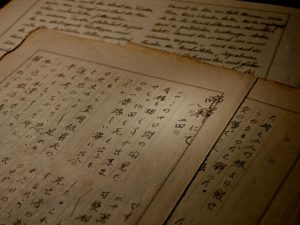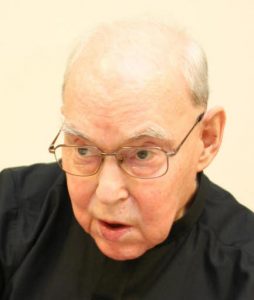Documenting Hiroshima of 1945: August 24, German priest who experienced atomic bombing asked for “Your peace”
Aug. 24, 2024
by Kyosuke Mizukawa, Senior Staff Writer
On August 24, 1945, while he was in the Taishakukyo Gorge area (in the present-day town of Jinsekikogen in Shobara City), located in the Chugoku mountain range, Father Klaus Luhmer, a German-born priest who died in 2011 at the age of 94, wrote a Japanese entry in a journal recalling the aftermath of the atomic bombing. He was one of 16 Jesuit priests and monks from overseas who experienced the bombing in Hiroshima on August 6.
According to that journal entry from August 24, 1945, “I encountered death in its most terrifying form many times … and I performed a funeral Mass for people who had died.”
He experienced the atomic bombing at the Nagatsuka Jesuit novitiate in the area of Gion-cho (now part of Hiroshima’s Asaminami Ward), around 4.5 kilometers from the hypocenter. The funeral Mass at which he delivered the sermon was held while he was still in Hiroshima. The same journal entry reads, “[At the Mass] there were around one, two, or three deaths in each family.”
He also wrote that, later, “The police issued an order for people to move to a distant place out of fear of military unrest.” Because there had been riots in Tokyo and other cities in reaction to Japan’s surrender, the police were believed to have been concerned that if non-Japanese were harmed in a similar incident, it would become a major issue.
Father Luhmer wrote that even those who had avoided instant death in the atomic bombing were dying in waves, concluding his journal with the words, “Lord, grant us Your peace!” However, the situation was far from settled.
Midori Naka, 36 at the time, died at a hospital affiliated with Tokyo Imperial University (present-day University of Tokyo), located in Tokyo, on August 24. She had been an actor with the Sakura Troupe, a traveling theatrical group, and experienced the atomic bombing at her lodging in the central area of Hiroshima City.
From the time of her admission to the hospital on August 16, she suffered such symptoms as an abnormally low white blood cell count, a high fever, and small petechial hemorrhaging spots on her body. A pathological autopsy was performed, and Masao Tsuzuki, a specialist in radiation medicine who died in 1961 at the age of 68, diagnosed her as having “A-bomb disease.” It is believed to have been the first case of such a diagnosis made by a specialist based on clinical course and pathological autopsy.
(Originally published on August 24, 2024)
On August 24, 1945, while he was in the Taishakukyo Gorge area (in the present-day town of Jinsekikogen in Shobara City), located in the Chugoku mountain range, Father Klaus Luhmer, a German-born priest who died in 2011 at the age of 94, wrote a Japanese entry in a journal recalling the aftermath of the atomic bombing. He was one of 16 Jesuit priests and monks from overseas who experienced the bombing in Hiroshima on August 6.
According to that journal entry from August 24, 1945, “I encountered death in its most terrifying form many times … and I performed a funeral Mass for people who had died.”
He experienced the atomic bombing at the Nagatsuka Jesuit novitiate in the area of Gion-cho (now part of Hiroshima’s Asaminami Ward), around 4.5 kilometers from the hypocenter. The funeral Mass at which he delivered the sermon was held while he was still in Hiroshima. The same journal entry reads, “[At the Mass] there were around one, two, or three deaths in each family.”
He also wrote that, later, “The police issued an order for people to move to a distant place out of fear of military unrest.” Because there had been riots in Tokyo and other cities in reaction to Japan’s surrender, the police were believed to have been concerned that if non-Japanese were harmed in a similar incident, it would become a major issue.
Father Luhmer wrote that even those who had avoided instant death in the atomic bombing were dying in waves, concluding his journal with the words, “Lord, grant us Your peace!” However, the situation was far from settled.
Midori Naka, 36 at the time, died at a hospital affiliated with Tokyo Imperial University (present-day University of Tokyo), located in Tokyo, on August 24. She had been an actor with the Sakura Troupe, a traveling theatrical group, and experienced the atomic bombing at her lodging in the central area of Hiroshima City.
From the time of her admission to the hospital on August 16, she suffered such symptoms as an abnormally low white blood cell count, a high fever, and small petechial hemorrhaging spots on her body. A pathological autopsy was performed, and Masao Tsuzuki, a specialist in radiation medicine who died in 1961 at the age of 68, diagnosed her as having “A-bomb disease.” It is believed to have been the first case of such a diagnosis made by a specialist based on clinical course and pathological autopsy.
(Originally published on August 24, 2024)









